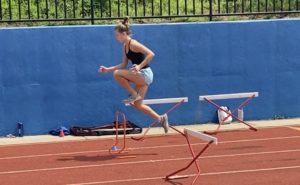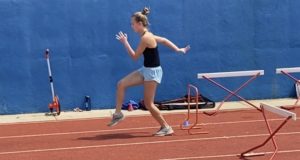Trail Leg, Stay Dorsi
by Steve McGill
Teaching trail leg mechanics to beginners can be a very tricky thing. Some pick up the basics almost instantly while others struggle mightily with the idea of opening up the groin as opposed to bringing the trail leg through directly under the body. This article is for those who struggle in that regard, and for coaches of those who struggle in that regard. My experience has been that, for some, doing reps of the fence drill on a regular basis solves the problem. With the fence drill, I can teach the “one-two-three” of the trail leg — 1) push off the ball of the foot, 2) drive the knee and heel upward while simultaneously opening up the groin, and 3) drive the knee to the front so that it is facing the front.
[am4show not_have=’g5;’]
[/am4show][am4guest]
[/am4guest][am4show have=’g5;’]
Some beginner hurdlers might do the fence drill correctly, but when it comes to actually running over hurdles, all they were doing right goes out the window and they revert to bringing the leg through directly under them. In such cases, we’ll proceed to side walk-overs with only the trail leg clearing the crossbar. Again, some beginners may do this drill correctly, but still revert to old habits when running over hurdles. In such cases, it’s important to continue doing these drills, and to also keep teaching sprint mechanics with A marches and A skips, as such drills are where the need to dorsiflex the ankles can be reinforced.
Dorsiflexion, really, is the key to everything. Nothing works if the ankles don’t remain dorsiflexed. What I have observed is that, in hurdling, the trail leg is the leg that is most prone to reverting back to plantar-flexion during hurdle clearance. Hurdlers who stay dorsiflexed in the strides between the hurdles, and who stay dorsiflexed with the lead leg while clearing the hurdle, still might revert to plantar-flexion with the trail leg right after take-off.
If this problem doesn’t fix itself naturally by doing the fence drill and the side walk-overs, we have to keep grinding with these drills. The lack of dorsiflexion is the reason the trail leg comes directly under the body instead of wrapping around like it should. Plantar-flexion causes the toe to point down, which causes the leg to kick back. And once the leg kicks back (knee pointing down) there’s no way to correct that because the athlete is in the air now. This type of trail leg forces the athlete to raise the hips way too much, so it looks like the athlete is “skying” over the hurdle vertically instead of pushing forward. This super-high hurdle clearance causes a huge loss of forward momentum, which, for beginners, can lead to three-stepping being impossible, even if they have the flat speed to do it. Most importantly, dropping the toe can cause the toe to catch hold of the crossbar, which will lead to a face-first crash and burn. That is the main reason that this issue must be addressed before it becomes ingrained.
Now, to show you what I’m talking about, let’s take a look at a photo sequence of one of my current beginners, Grace Galloway, doing a marching popover drill.

In this first photo, Grace has just left the ground, and, as I discussed above, her lead leg foot is dorsiflexed, but her trail leg foot is not. Were I standing behind Grace, I should be seeing the heel of her foot (like I do with the lead leg), not the soul of her foot (like I do with the trail leg). Now, to be clear, plenty of hurdlers will momentarily lose dorsiflexion of the trail leg immediately after take-off, and then re-dorsiflex as they drive the knee forward. But when you’re talking about beginners, that is rarely the case; once they lose dorsiflexion, they don’t get it back. In the next few photos, you’ll see how this is true. Meanwhile, look at how high she is over the hurdle. That’s because the trail leg is coming directly under her, which is happening because her ankle isn’t dorsiflexed.
 In this second photo, Grace is descending off the hurdle, her center of mass over the hurdle. Again, the toe of her trail leg is pointing down. She is doing other things well — good upper body posture, the lead leg is dorsiflexed and is beginning to cycle back under her hip. But the trail leg positioning is ruining everything.
In this second photo, Grace is descending off the hurdle, her center of mass over the hurdle. Again, the toe of her trail leg is pointing down. She is doing other things well — good upper body posture, the lead leg is dorsiflexed and is beginning to cycle back under her hip. But the trail leg positioning is ruining everything.
 In this third photo, Grace’s lead leg has touched down, and it cycled back under her hip like we wanted to. But the foot of the trail leg, as you can see, is “reaching” for the track, as I like to say. Back in the day, when I saw the foot reaching for the track like that, I’d try to fix the problem at that phase of hurdle clearance. Now I know it needs to be addressed at take-off.
In this third photo, Grace’s lead leg has touched down, and it cycled back under her hip like we wanted to. But the foot of the trail leg, as you can see, is “reaching” for the track, as I like to say. Back in the day, when I saw the foot reaching for the track like that, I’d try to fix the problem at that phase of hurdle clearance. Now I know it needs to be addressed at take-off.
 In this fourth photo, Grace’s trail leg has touched down, and you can see how the toe is pointing down, and how the foot is landing in front of the hip, which means her ground contact time will be quite lengthy, and her hips will drop before she pushes off for her next stride.
In this fourth photo, Grace’s trail leg has touched down, and you can see how the toe is pointing down, and how the foot is landing in front of the hip, which means her ground contact time will be quite lengthy, and her hips will drop before she pushes off for her next stride.
Later in this same workout, I had Grace do some cycle drilling over 27-inch hurdles, and she did start opening the groin of her trail leg. It caused her hips to twist a little bit, but, as I said to her, happy with excitement, that’s the problem we want to have, because it’s a pretty easy fix. And, it means that she’s learning to execute the motion properly. But getting her to the point where that foot stays dorsiflexed from the ground to the ground is going to take a lot of repetition for a good number of weeks, and maybe even months. My experience has been that when an athlete is focused on improving a specific aspect of technique, the moment will come when everything “clicks,” but that it’s impossible to predict when that will happen. So you have to stay patient and persistent and creative.
[/am4show]
